Association between the Biophysical Environment in Coastal South China Sea and Large-Scale Synoptic Circulation Patterns: The Role of the Northwest Pacific Subtropical High and Typhoons
Abstract
:1. Introduction
2. Materials and Methods
2.1. Multisatellite Data
2.2. Classification of Synoptic Types
- (1)
- Type 1 is located in the southerly winds on the west side of the NWPSH, which is mainly controlled by the NWPSH. Such conditions are not conducive to ascending motion and precipitation is relatively low.
- (2)
- In Type 2, the westerly trough deepens meridionally, and the NWPSH advances northward, presenting two anticyclonic centers (Figure 1b). The SCS is located between the Indian low and the NWPSH, and is jointly controlled by both. At the front of the NWPSH bottom forms a southerly wind blowing from the ocean to the mainland.
- (3)
- While the NWPSH retreats eastward during Type 3, a warm high pressure is formed in North China. The enhancement of low pressure on the west side produces two centers. The SCS is mainly affected by low pressure, and the ascending motion is strong. Southwestward warm and wet airflow makes the rainfall increase.
- (4)
- In Type 4, the warm high pressure north of the SCS extends westward and advances northward, moving completely to the north side of the SCS. A strong low-pressure center appears in northeastern India, extending eastward to the SCS, at which time the SCS forms southwesterly to southeasterly winds.
2.3. Significant-Difference Test
3. Results
3.1. Summer Hydrometeorological Environment Distribution in the SCS
3.2. Disparities of the Biophysical Environment in the SCS under Different LSCPs
3.3. Potential Drivers of chl-a under Different LSCPs
4. Discussion
4.1. Contribution of Typhoons under Different LSCPs
4.2. Roles of Various Wind Vectors under Different LSCPs
5. Conclusions
Supplementary Materials
Author Contributions
Funding
Data Availability Statement
Conflicts of Interest
References
- Ryther, J.H.; Yentsch, C.S. The estimation of phytoplankton production in the ocean from chlorophyll and light data. Limnol. Oceanogr. 1957, 2, 281–286. [Google Scholar] [CrossRef]
- Bai, Y.; Pan, D.; Guan, W.; He, X. Ocean primary production estimate of China Sea by hy-1a/cocts. Proc. SPIE 2005, 597704. [Google Scholar] [CrossRef]
- Lomas, M.W.; Moran, S.B.; Casey, J.R.; Bell, D.W.; Tiahlo, M.; Whitefield, J.; Kelly, R.P.; Mathis, J.T.; Cokelet, E.D. Spatial and seasonal variability of primary production on the Eastern Bering Sea shelf. Deep Sea Res. Part II 2012, 65, 126–140. [Google Scholar] [CrossRef]
- Liu, Y.; Tang, D.; Evgeny, M. Chlorophyll Concentration Response to the Typhoon Wind-Pump Induced Upper Ocean Processes Considering Air–Sea Heat Exchange. Remote Sens. 2019, 11, 1825. [Google Scholar] [CrossRef] [Green Version]
- Hays, G.C.; Richardson, A.J.; Robinson, C. Climate change and marine plankton. Trends Ecol. Evol. 2005, 20, 337–344. [Google Scholar] [CrossRef]
- Lin, I.I. Typhoon-induced phytoplankton blooms and primary productivity increase in the western North Pacific subtropical ocean. J. Geophys. Res. 2012, 117. [Google Scholar] [CrossRef]
- Tang, D.; Kawamura, H.; Van Dien, T.; Lee, M. Offshore phytoplankton biomass increase and its oceanographic causes in the South China Sea. Mar. Ecol. Prog. Ser. 2004, 268, 31–41. [Google Scholar] [CrossRef]
- Sun, L.; Yang, Y.; Xian, T.; Lu, Z.; Fu, Y. Strong enhancement of chlorophyll a concentration by a weak typhoon. Mar. Ecol. Prog. Ser. 2010, 39–50. [Google Scholar] [CrossRef]
- Waliser, D.E.; Murtugudde, R.; Strutton, P.; Li, J.L. Subseasonal organization of ocean chlorophyll: Prospects for prediction based on the Madden-Julian Oscillation. Geophys. Res. Lett. 2005, 32, L23602. [Google Scholar] [CrossRef]
- Liu, S.; Tang, D.; Yan, H.; Ning, G.; Liu, C.; Yang, Y. Potential Associations between Low-Level Jets and Intraseasonal and Semi-Diurnal Variations in Coastal Chlorophyll—A over the Beibuwan Gulf, South China Sea. Remote Sens. 2021, 13, 1194. [Google Scholar] [CrossRef]
- Cham, D.D.; Son, N.T.; Minh, N.Q.; Thanh, N.T.; Dung, T.T. An analysis of shoreline changes using combined multitemporal remote sensing and digital evaluation model. Civ. Eng. J. 2020, 6, 1–10. [Google Scholar] [CrossRef]
- Hu, S.; Zhou, W.; Wang, G.; Cao, W.; Xu, Z.; Liu, H.; Wu, G.; Zhao, W. Comparison of Satellite-Derived Phytoplankton Size Classes Using In-Situ Measurements in the South China Sea. Remote Sens. 2018, 10, 526. [Google Scholar] [CrossRef] [Green Version]
- Kutser, T. Quantitative detection of chlorophyll in cyanobacterial blooms by satellite remote sensing. Limnol. Oceanogr. 2004, 49, 2179–2189. [Google Scholar] [CrossRef]
- Solanki, H.U.; Mankodi, P.C.; Dwivedi, R.M.; Nayak, S. Satellite observations of main oceanographic processes to identify ecological associations in the Northern Arabian Sea for fishery resources exploration. Hydrobiologia 2008, 612, 269–279. [Google Scholar] [CrossRef]
- Gholami, D.M.; Baharlouii, M. Monitoring long-term mangrove shoreline changes along the northern coasts of the Persian Gulf and the Oman Sea. Emerg. Sci. J. 2019, 3, 88–100. [Google Scholar] [CrossRef] [Green Version]
- Warren, M.A.; Quartly, G.D.; Shutler, J.D.; Miller, P.I.; Yoshikawa, Y. Estimation of Ocean Surface Currents from Maximum Cross Correlation applied to GOCI geostationary satellite remote sensing data over the Tsushima (Korea) Straits. J. Geophys. Res. Oceans 2016, 121, 6993–7009. [Google Scholar] [CrossRef] [Green Version]
- Ciani, D.; Charles, E.; Nardelli, B.; Rio, M.H.; Santoleri, R. Ocean currents reconstruction from a combination of altimeter and ocean colour data: A feasibility study. Remote Sens. 2021, 13, 2389. [Google Scholar] [CrossRef]
- Liu, Y.; Tang, D.; Tang, S.; Evgeny, M.; Liang, W.; Sui, Y. A case study of Chlorophyll a response to tropical cyclone Wind Pump considering Kuroshio invasion and air-sea heat exchange. Sci. Total Environ. 2020, 741. [Google Scholar] [CrossRef] [PubMed]
- Palacz, A.P.; Xue, H.; Armbrecht, C.; Zhang, C.; Chai, F. Seasonal and inter-annual changes in the surface chlorophyll of the South China Sea. J. Geophys. Res. 2011, 116. [Google Scholar] [CrossRef]
- Vantrepotte, V.; Mélin, F. Inter-annual variations in the seawifs global chlorophyll a concentration (1997–2007). Deep Sea Res. Part I 2011, 58, 429–441. [Google Scholar] [CrossRef]
- Gong, G.C.; Liu, K.K.; Liu, C.T.; Pai, S.C. The chemical hydrography of the South China Sea west of Luzon and a comparison with the West Philippine Sea. Terr. Atmos. Ocean. Sci. 1993, 3, 587–602. Available online: http://140.112.114.62/handle/246246/114465 (accessed on 12 April 2021). [CrossRef]
- Liang, W.; Tang, D.; Luo, X. Phytoplankton size structure in the western South China Sea under the influence of a ‘jet-eddy system’. J. Mar. Syst. 2018, 187, 82–95. [Google Scholar] [CrossRef]
- Pan, G.; Chai, F.; Tang, D.L.; Wang, D.X. Marine phytoplankton biomass responses to typhoon events in the South China Sea based on physical-biogeochemical model. Ecol. Model. 2017, 356, 38–47. [Google Scholar] [CrossRef]
- Siswanto, E.; Ye, H.J.; Yamazaki, D.; Tang, D.L. Detailed spatiotemporal impacts of El Niño on phytoplankton biomass in the South China Sea. J. Geophys. Res. Oceans 2017, 122, 2709–2723. [Google Scholar] [CrossRef]
- Wang, J.J.; Tang, D.L.; Sui, Y. Winter phytoplankton bloom induced by subsurface upwelling and mixed layer entrainment southwest of Luzon strait. J. Marine Syst. 2010, 83, 141–149. [Google Scholar] [CrossRef]
- Yan, H.; Liu, C.C.; An, Z.S.; Yang, W.; Yang, Y.J.; Huang, P.; Qiu, S.C.; Zhou, P.C.; Zhao, N.Y.; Fei, H.B.; et al. Extreme weather events recorded by daily to hourly resolution biogeochemical proxies of marine giant clam shells. Proc. Natl. Acad. Sci. USA 2020, 117, 201916784. [Google Scholar] [CrossRef] [Green Version]
- Ye, H.J.; Sheng, J.Y.; Tang, D.L.; Siswanto, E.; Kalhoro, M.A.; Sui, Y. Storm-induced changes in pco2 at the sea surface over the northern south china sea during typhoon wutip. J. Geophys. Res. Oceans 2017, 122, 4761–4778. [Google Scholar] [CrossRef]
- He, L.; Yin, K.; Yuan, X.; Li, D.; Zhang, D.; Harrison, P. Spatial distribution of viruses, bacteria and chlorophyll in the northern South China Sea. Aquat. Microb. Ecol. 2009, 54, 153–162. [Google Scholar] [CrossRef] [Green Version]
- Nguyen, T.; Hoang, T.D. Studies on phytoplankton pigments: Chlorophyll, total carotenoids and degradation products in Vietnamese waters. In Proceedings of the Fourth Technical Seminar on Marine Fishery Resources Survey in the South China Sea, Area IV: Vietnamese Waters, Bangkok, Thailand, 18–20 September 2000; pp. 233–250. [Google Scholar]
- Wu, M.; Wang, Y.; Wang, Y.; Yin, J.; Dong, J.; Jiang, Z.; Sun, F. Scenarios of nutrient alterations and responses of phytoplankton in a changing Daya Bay, South China Sea. J. Mar. Syst. 2017, 165, 1–12. [Google Scholar] [CrossRef]
- Tang, D.; Kawamura, H.; Doannhu, H.; Takahashi, W. Remote sensing oceanography of a harmful algal bloom off the coast of southeastern Vietnam. J. Geophys. Res. 2004, 109. [Google Scholar] [CrossRef]
- Xie, S.P.; Xie, Q.; Wang, D.; Liu, W.T. Summer upwelling in the South China Sea and its role in regional climate variations. J. Geophys. Res. 2003, 108. [Google Scholar] [CrossRef] [Green Version]
- Wang, J.; Tang, D.L. Phytoplankton patchiness during spring intermonsoon in western coast of South China Sea. Deep Sea Res. Part II 2014, 101, 120–128. [Google Scholar] [CrossRef]
- Liu, H.; Song, X.; Huang, L.; Tan, Y.; Zhang, J. Phytoplankton biomass and production in northern South China Sea during summer: Influenced by Pearl River discharge and coastal upwelling. Acta Ecol. Sin. 2011, 31, 133–136. [Google Scholar] [CrossRef]
- Song, X.; Lai, Z.; Ji, R.; Chen, C.; Zhang, J.; Huang, L.; Yin, J.; Wang, Y.; Lian, S.; Zhu, X. Summertime primary production in northwest South China Sea: Interaction of coastal eddy, upwelling and biological processes. Cont. Shelf Res. 2012, 48, 110–121. [Google Scholar] [CrossRef]
- Yang, Y.J.; Xian, T.; Sun, L.; Fu, Y. Summer Monsoon Impacts on Chlorophyll-a Concentration in the Middle of the South China Sea: Climatological Mean and Annual Variability. Atmos. Ocean. Sci. Lett. 2012, 5, 15–19. [Google Scholar] [CrossRef]
- Liu, F.; Chen, C.; Zhan, H. Decadal variability of chlorophyll a in the South China Sea: A possible mechanism. Chin. J. Oceanol. Limn. 2012, 30, 1054–1062. [Google Scholar] [CrossRef] [Green Version]
- Kuo, N.; Ho, C.; Lo, Y.; Huang, S.; Chang, L. Analysis of chlorophyll-a concentration around the South China Sea from ocean color images. In Proceedings of the OCEANS 2009-EUROPE, Bremen, Germany, 11–14 May 2009. [Google Scholar] [CrossRef]
- Liu, K.; Wang, L.; Dai, M.; Tseng, C.; Yang, Y.; Sui, C.; Oey, L.; Tseng, K.; Huang, S. Inter-annual variation of chlorophyll in the northern South China Sea observed at the SEATS Station and its asymmetric responses to climate oscillation. Biogeosciences 2013, 10, 7449–7462. [Google Scholar] [CrossRef] [Green Version]
- Lin, J.; Tang, D.; Alpers, W.; Wang, S. Response of dissolved oxygen and related marine ecological parameters to a tropical cyclone in the South China Sea. Adv. Space Res. 2014, 53, 1081–1091. [Google Scholar] [CrossRef]
- Shang, S.; Li, L.; Sun, F.; Wu, J.; Hu, C.; Chen, D.; Ningm, X.; Qiu, Y.; Zhang, C.; Shang, S. Changes of temperature and bio-optical properties in the South China Sea in response to Typhoon Lingling, 2001. Geophys. Res. Lett. 2008, 35. [Google Scholar] [CrossRef] [Green Version]
- Ye, H.J.; Sui, Y.; Tang, D.L.; Afanasyev, Y.D. A subsurface chlorophyll a bloom induced by typhoon in the South China Sea. J. Mar. Syst. 2013, 128, 138–145. [Google Scholar] [CrossRef]
- Yue, X.; Zhang, B.; Liu, G.; Li, X.; Zhang, H.; He, Y. Upper Ocean Response to Typhoon Kalmaegi and Sarika in the South China Sea from Multiple-Satellite Observations and Numerical Simulations. Remote Sens. 2018, 10, 348. [Google Scholar] [CrossRef] [Green Version]
- Zhao, H.; Tang, D.; Wang, Y. Comparison of phytoplankton blooms triggered by two typhoons with different intensities and translation speeds in the South China Sea. Mar. Ecol. Prog. Ser. 2008, 365, 57–65. [Google Scholar] [CrossRef] [Green Version]
- Ramos, A.M.; Pires, A.C.; Sousa, P.; Trigo, R.M. The use of circulation weather types to predict upwelling activity along the western Iberian Peninsula coast. Cont. Shelf Res. 2013, 69, 38–51. [Google Scholar] [CrossRef]
- Moron, V.; Gouirand, I.; Taylor, M. Weather types across the Caribbean basin and their relationship with rainfall and sea surface temperature. Clim. Dyn. 2016, 47, 601–621. [Google Scholar] [CrossRef]
- Picado, A.; Lorenzo, M.N.; Alvarez, I.; Decastro, M.; Vaz, N.; Dias, J.M. Upwelling and Chl-a spatiotemporal variability along the Galician coast: Dependence on circulation weather types. Int. J. Climatol. 2016, 36, 3280–3296. [Google Scholar] [CrossRef]
- Murakami, H. Ocean color estimation by Himawari-8/AHI. Proc. SPIE 2016, 9878, 987810. [Google Scholar] [CrossRef]
- Liu, X.; Wang, M. Analysis of ocean diurnal variations from the Korean Geostationary Ocean Color Imager measurements using the DINEOF method. Estuar. Coast. Shelf Sci. 2016, 180, 230–241. [Google Scholar] [CrossRef]
- Wang, M.; Ahn, J.; Jiang, L.; Shi, W.; Son, S.; Park, Y.; Ryu, J. Ocean color products from the Korean Geostationary Ocean Color Imager (GOCI). Opt. Express 2013, 21, 3835–3849. [Google Scholar] [CrossRef]
- Ryu, J.; Han, H.; Cho, S.; Park, Y.; Ahn, Y. Overview of geostationary ocean color imager (GOCI) and GOCI data processing system (GDPS). Ocean Sci. J. 2012, 47, 223–233. [Google Scholar] [CrossRef]
- Iwasaki, S. Daily Variation of Chlorophyll-A Concentration Increased by Typhoon Activity. Remote Sens. 2020, 12, 1259. [Google Scholar] [CrossRef] [Green Version]
- Price, J.F. Upper ocean response to a hurricane. J. Phys. Oceanogr. 1981, 11, 153–175. [Google Scholar] [CrossRef] [Green Version]
- Jaimes, B.; Shay, L.K. Enhanced wind-driven downwelling flow in warm oceanic eddy features during the intensification of Tropical Cyclone Isaac (2012): Observations and theory. J. Phys. Oceanogr. 2015, 45, 1667–1689. [Google Scholar] [CrossRef]
- Powell, M.D.; Vickery, P.J.; Reinhold, T.A. Reduced drag coefficient for high wind speeds in tropical cyclones. Nature 2003, 422, 279–283. [Google Scholar] [CrossRef] [PubMed]
- Chereskin, T.K.; Price, J.F. Ekman Transport and Pumping. In Encyclopedia of Ocean Sciences, 1st ed.; Steele, J.H., Ed.; Academic Press: Cambridge, MA, USA, 2001; pp. 809–815. [Google Scholar] [CrossRef]
- Abdulrazzaq, Z.T.; Hasan, R.H.; Aziz, N.A. Integrated TRMM Data and Standardized Precipitation Index to Monitor the Meteorological Drought. Civ. Eng. J. 2019, 5, 1590–1598. [Google Scholar] [CrossRef] [Green Version]
- Kuriqi, A. Assessment and quantification of meteorological data for implementation of weather radar in mountainous regions. Mausam 2016, 67, 789–802. [Google Scholar]
- Yang, Y.J.; Wang, H.; Chen, F.J.; Zheng, X.Y.; Fu, Y.F.; Zhou, S.X. TRMM-based Optical and Microphysical Features of Precipitating Clouds in Summer over the Yangtze-Huaihe River Valley, China. Pure Appl. Geophys. 2019, 176, 357–370. [Google Scholar] [CrossRef]
- Compagnucci, R.H.; Richman, M.B. Can principal component analysis provide atmospheric circulation or teleconnection patterns? Int. J. Climatol. 2008, 28, 703–726. [Google Scholar] [CrossRef]
- Huth, R. An example of using obliquely rotated principal components to detect circulation types over Europe. Meteorol. Ztschrift 1993, 2, 285–293. [Google Scholar] [CrossRef]
- Zong, L.; Yang, Y.J.; Wang, H.; Ning, G.C.; Li, Y.B.; Gao, Z.Q.; Liu, C.; Wang, L.L. Synoptic drivers of co-occurring surface ozone and PM2.5 pollution during summertime ineastern China. Atmos. Chem. Phys. 2021, 21, 9105–9124. [Google Scholar] [CrossRef]
- Yang, Y.J.; Wang, R.; Chen, F.J.; Liu, C.; Bi, X.Y.; Huang, M. Synoptic weather patterns modulate the frequency, type and vertical structure of summer precipitation over Eastern China: A perspective from GPM observations. Atmos. Res. 2020, 05342. [Google Scholar] [CrossRef]
- Hoffmann, P.; Heinke SchlüNzen, K. Weather pattern classification to represent the urban heat island in present and future climate. J. Appl. Meteorol. Clim. 2013, 52, 2699–2714. [Google Scholar] [CrossRef]
- Philipp, A.; Beck, C.; Esteban, P.; Krennert, T.; Lochbihler, K.; Spyros, P.; Pianko-kluczynska, K.; Post, P.; Alvarez, R.; Spekat, A.; et al. Cost733 User Guide; University of Augsburg: Augsburg, Germany, 2014. [Google Scholar]
- Ning, G.; Yim, S.H.L.; Wang, S.; Duan, B.; Nie, C.; Yang, X.; Wang, J.; Shang, K. Synergistic effects of synoptic weather patterns and topography on air quality: A case of the Sichuan Basin of China. Clim. Dynam. 2019, 53, 6729–6744. [Google Scholar] [CrossRef]
- Vlasova, G.A.; Demenok, M.N.; Xuan, N.B.; Long, B.H. The role of atmospheric circulation in spatial and temporal variations in the structure of currents in the western South China Sea. Izv. Atmos. Ocean. Phys. 2016, 52, 317–327. [Google Scholar] [CrossRef]
- He, X.Z.; Gong, D.Y. Interdecadal change in Western Pacific Subtropical High and climatic effects. J. Geogr. Sci. 2002, 12, 202–209. [Google Scholar] [CrossRef]
- Dippner, J.W.; Nguyen, K.V.; Hein, H.; Ohde, T.; Loick, N. Monsoon-induced upwelling off the Vietnamese coast. Ocean Dynam. 2007, 57, 46–62. [Google Scholar] [CrossRef]
- Wang, G.; Chen, D.; Su, J. Generation and life cycle of the dipole in the South China. Sea summer circulation. J. Geophys. Res. 2006, 111. [Google Scholar] [CrossRef] [Green Version]
- Chen, C.; Lai, Z.; Beardsley, R.C.; Xu, Q.; Lin, H.; Viet, N.T. Current separation and upwelling over the southeast shelf of Vietnam in the South China Sea. J. Geophys. Res. 2012, 117. [Google Scholar] [CrossRef] [Green Version]
- Wang, D.; Wang, Q.; Cai, S.; Cai, S.; Shang, X.; Peng, S.; Shu, Y.; Xiao, J.; Xie, X.H.; Zhang, Z.; et al. Advances in research of the mid-deep South China Sea circulation. Sci. China Earth Sci. 2019, 62, 1992–2004. [Google Scholar] [CrossRef]
- Xu, H.; Xie, S.P.; Wang, Y.; Zhuang, W.; Wang, D. Orographic effects on South China Sea summer climate. Meteorol. Atmos. Phys. 2008, 100, 275–289. [Google Scholar] [CrossRef]
- Yan, Y.; Wang, G.; Wang, C.; Su, J. Low-salinity water off West Luzon Island in summer. J. Geophys. Res. 2015, 120, 3011–3021. [Google Scholar] [CrossRef]
- Ou, S.; Zhang, H.; Wang, D.X. Dynamics of the buoyant plume off the Pearl River Estuary in summer. Environ. Fluid Mech. 2009, 9, 471–492. [Google Scholar] [CrossRef] [Green Version]
- Bai, Y.; Huang, T.H.; He, X.; Wang, S.L.; Hsin, Y.C.; Wu, C.R.; Zhai, W.D.; Lui, H.K.; Chen, C.T.A. Intrusion of the Pearl River plume into the main channel of the Taiwan Strait in summer. J. Sea Res. 2015, 95, 1–15. [Google Scholar] [CrossRef]
- Yang, W.; Dong, Y.; Zu, T.T.; Liu, C.J.; Xiu, P. Distribution of Chlorophyll-a and its influencing factors in the northern South China Sea in summer. J. Trop. Oceangr. 2019, 38, 9–20. (In Chinese) [Google Scholar] [CrossRef]
- Shen, S.; Leptoukh, G.G.; Acker, J.G.; Yu, Z.; Kempler, S.J. Seasonal variations of chlorophyll, a concentration in the northern South China Sea. IEEE Geosci. Remote Sens. 2008, 5, 315–319. [Google Scholar] [CrossRef]
- Tang, D.L.; Kawamura, H.; Lee, M.A.; Dien, T.V. Seasonal and spatial distribution of chlorophyll-a concentrations and water conditions in the gulf of Tonkin, South China sea. Remote Sens. Environ. 2003, 85, 475–483. [Google Scholar] [CrossRef]
- Julian, P.; Whitehouse, M.J.; Angus, A.; Brierley, A.S.; Murphy, E.J. Diurnal changes in near-surface ammonium concentration—interplay between zooplankton and phytoplankton. J. Plankton Res. 1997, 9, 1305–1330. [Google Scholar] [CrossRef]
- Noh, J.H.; Kim, W.; Son, S.H.; Ahn, J.H.; Park, Y.J. Remote quantification of cochlodinium polykrikoides blooms occurring in the east sea using geostationary ocean color imager (GOCI). Harmful Algae 2018, 73, 129–137. [Google Scholar] [CrossRef] [PubMed]
- Wang, L.; Guan, Z.; He, J. The position variation of the West Pacific subtropical high and its possible mechanism. J. Trop. Meteorol. 2006, 12, 113–120. [Google Scholar]
- Zu, T.; Wang, D.; Wang, Q.; Li, M.; Chen, J. A revisit of the interannual variation of the south china sea upper layer circulation in summer: Correlation between the eastward jet and northward branch. Clim. Dynam. 2019, 54. [Google Scholar] [CrossRef]
- Mesquita, M.C.B.; Prestes, A.C.C.; Gomes, A.M.A.; Marinho, M.M. Direct effects of temperature on growth of different tropical phytoplankton species. Microb. Ecol. 2019, 79. [Google Scholar] [CrossRef]
- Wang, T.; Zhong, Z.; Sun, Y.; Wang, J. Impacts of tropical cyclones on the meridional movement of the western Pacific subtropical high. Atmos. Sci. Lett. 2019, e893. [Google Scholar] [CrossRef]
- Wang, G.; Ling, Z.; Wang, C. Influence of tropical cyclones on seasonal ocean circulation in the South China Sea. J. Geophys. Res. 2009, 114. [Google Scholar] [CrossRef] [Green Version]
- Yu, Y.; Xing, X.; Liu, H.; Yuan, Y.; Wang, Y.; Chai, F. The variability of chlorophyll-a and its relationship with dynamic factors in the basin of the South China Sea. J. Mar. Syst. 2019, 200, 103230. [Google Scholar] [CrossRef]
- Ren, F.; Gleason, B.; Easterling, D. Typhoon impacts on China’s precipitation during 1957-1996. Adv. Atmos. Sci. 2002, 19, 943–952. [Google Scholar] [CrossRef]
- Wang, G.; Su, J.; Ding, Y.; Chen, D. Tropical cyclone genesis over the South China Sea. J. Mar. Syst. 2007, 68, 318–326. [Google Scholar] [CrossRef]
- Sun, J.; Xu, F.; Oey, L.; Lin, Y. Monthly variability of tropical cyclone intensity change over the Northern South China Sea in recent decades. Clim. Dynam. 2018, 3631–3642. [Google Scholar] [CrossRef]
- Chen, Y.; Tang, D. Remote sensing analysis of impact of typhoon on environment in the sea area south of Hainan Island. Procedia Environ. Sci. 2011, 10, 1621–1629. [Google Scholar] [CrossRef] [Green Version]
- Shang, X.D.; Zhu, H.B.; Chen, G.Y.; Xu, C.; Yang, Q. Research on cold core eddy change and phytoplankton bloom induced by typhoons: Case studies in the South China Sea. Adv. Meteorol. 2015, 34042. [Google Scholar] [CrossRef] [Green Version]
- Sun, L.; Yang, Y.J.; Xian, T.; Wang, Y.; Fu, Y.F. Ocean responses to Typhoon Namtheun explored with Argo floats and multiplatform satellites. Atmos. Ocean 2012, 50 (Suppl. 1), 15–26. [Google Scholar] [CrossRef] [Green Version]
- Sun, L.; Li, Y.X.; Yang, Y.J.; Wu, Q.Y.; Chen, X.T.; Li, Q.Y.; Li, Y.B.; Xian, T. Effects of super typhoons on cyclonic ocean eddies in the western North Pacific: A satellite data-based evaluation between 2000 and 2008. J. Geophys. Res. 2014, 119, 5585–5598. [Google Scholar] [CrossRef]
- Yang, Y.J.; Sun, L.; Liu, Q.; Xian, T.; Fu, Y.F. The biophysical responses of the upper ocean to the typhoons namtheun and malou in 2004. Int. J. Remote Sens. 2010, 31, 4559–4568. [Google Scholar] [CrossRef]
- Yang, Y.J.; Sun, L.; Duan, A.M.; Li, Y.B.; Fu, Y.F.; Yan, Y.F. Impacts of the binary typhoons on upper ocean environments in November 2007. J. Appl. Remote Sens. 2012, 6, 063583. [Google Scholar] [CrossRef]
- Zhang, S.; Xie, L.; Hou, Y.; Zhao, H.; Qi, Y.; Yi, X. Tropical storm-induced turbulent mixing and chlorophyll-a enhancement in the continental shelf southeast of Hainan Island. J. Mar. Syst. 2014, 129, 405–414. [Google Scholar] [CrossRef] [Green Version]
- Zhao, H.; Tang, D.L.; Wang, D.X. Phytoplankton blooms near the Pearl River estuary induced by Typhoon Nuri. J. Geophys. Res. 2009, 114. [Google Scholar] [CrossRef]
- Liu, S.H.; Li, J.G.; Sun, L.; Wang, G.H.; Tang, D.L.; Huang, P.; Yan, H.; Gao, S.; Liu, C.; Gao, Z.Q.; et al. Basin-wide responses of the South China Sea environment to Super Typhoon Mangkhut (2018). Sci. Total Environ. 2020, 731, 139093. [Google Scholar] [CrossRef]
- Chen, Y.; Chen, X. Modeling transport and distribution of suspended sediments in Pearl River estuary. J. Coastal Res. 2008, 24, 163–170. [Google Scholar] [CrossRef]
- Fu, D.; Pan, D.; Mao, Z.; Ding, Y.; Chen, J. The effects of chlorophyll-a and SST in the South China Sea area by typhoon near last decade. Proc. SPIE 2009, 74782E. [Google Scholar] [CrossRef]
- Xu, F.; Yao, Y.; Oey, L.-Y.; Lin, Y. Impacts of preexisting ocean cyclonic circulation on sea surface chlorophyll-a concentration off northeastern Taiwan following episodic typhoon passages. J. Geophys. Res. Oceans 2017, 122, 6482–6497. [Google Scholar] [CrossRef]
- Lu, R.-Y. Interannual variability of the summertime North Pacific subtropical high and its relation to atmospheric convection over the Warm Pool. J. Meteorol. Soc. Jpn. 2001, 79, 771–783. [Google Scholar] [CrossRef] [Green Version]
- Holligan, P.M. Biological implications of fronts on the northwest european continental shelf. Philos. Trans. R. Soc. 1981, 302, 547–562. [Google Scholar] [CrossRef]
- Tijani, K.; Chiaradia, M.T.; Morea, A.; Nutricato, R.; Guerriero, L.; Pasquariello, G. Fishing forecasting system in Adriatic sea—A model approach based on a normalized scalar product of the SST gradient and CHL gradient vectors. In Proceedings of the 2015 IEEE International Geoscience and Remote Sensing Symposium (IGARSS), Milan, Italy, 26–31 July 2015; pp. 2257–2260. [Google Scholar] [CrossRef]





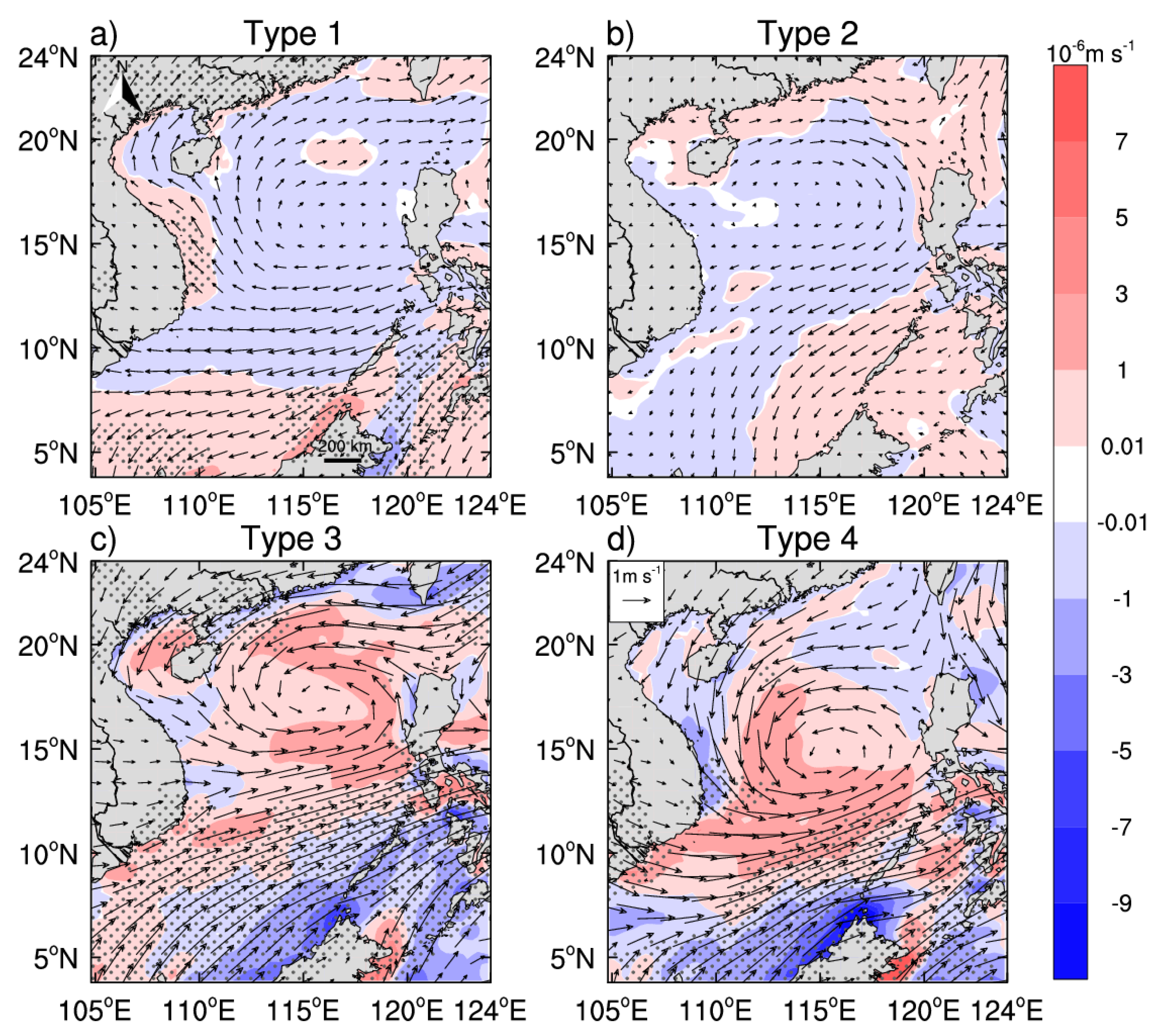
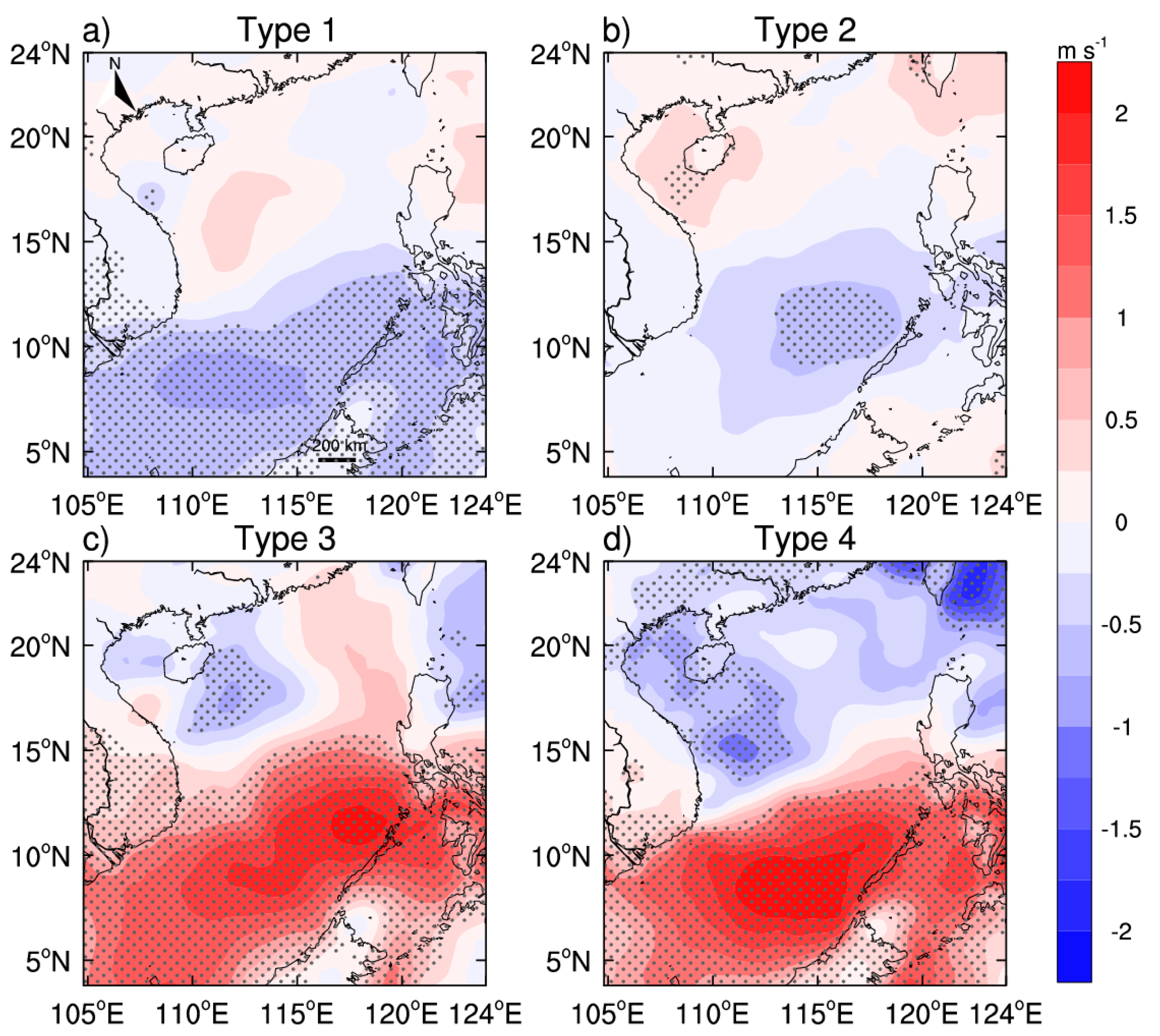

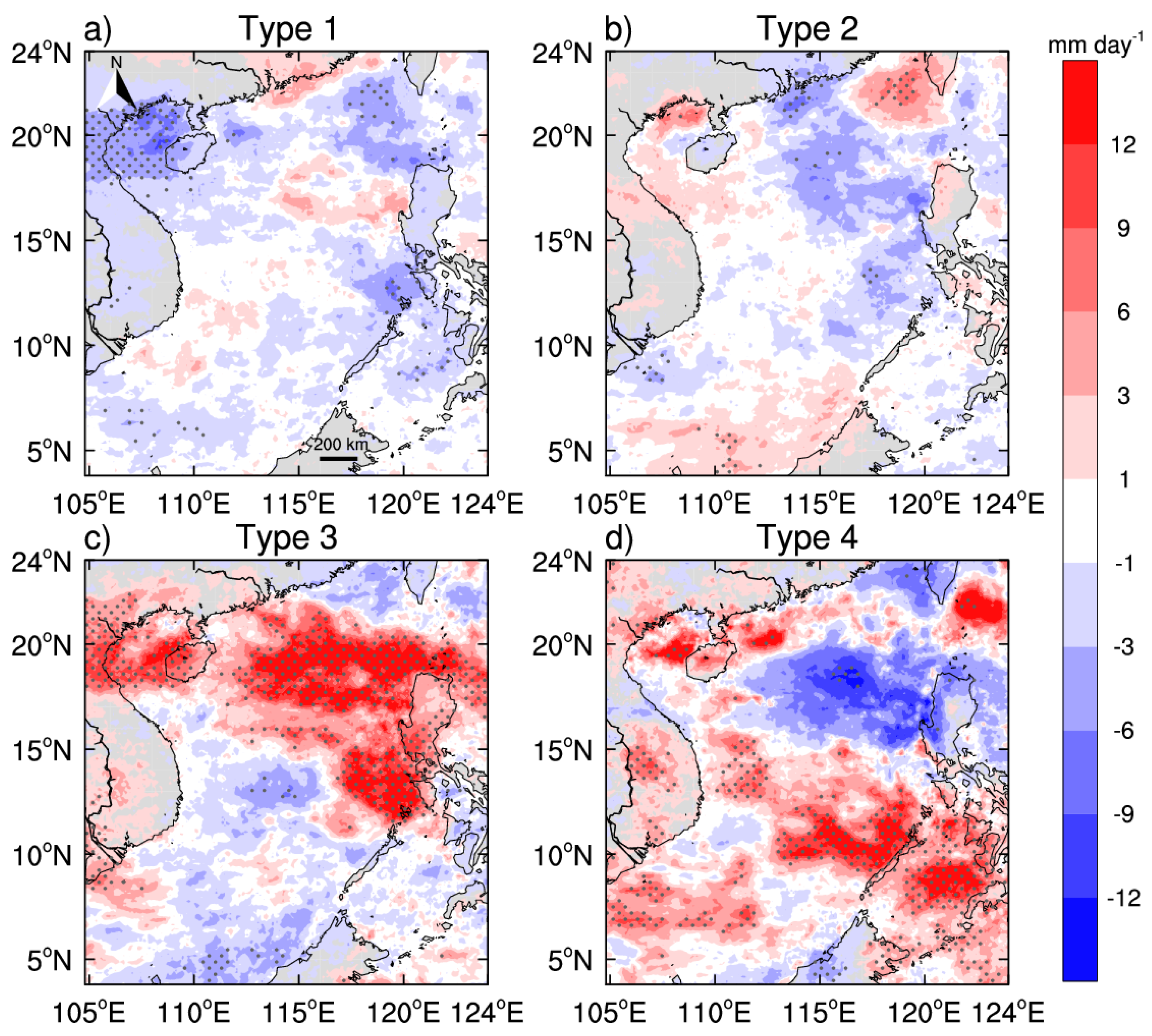


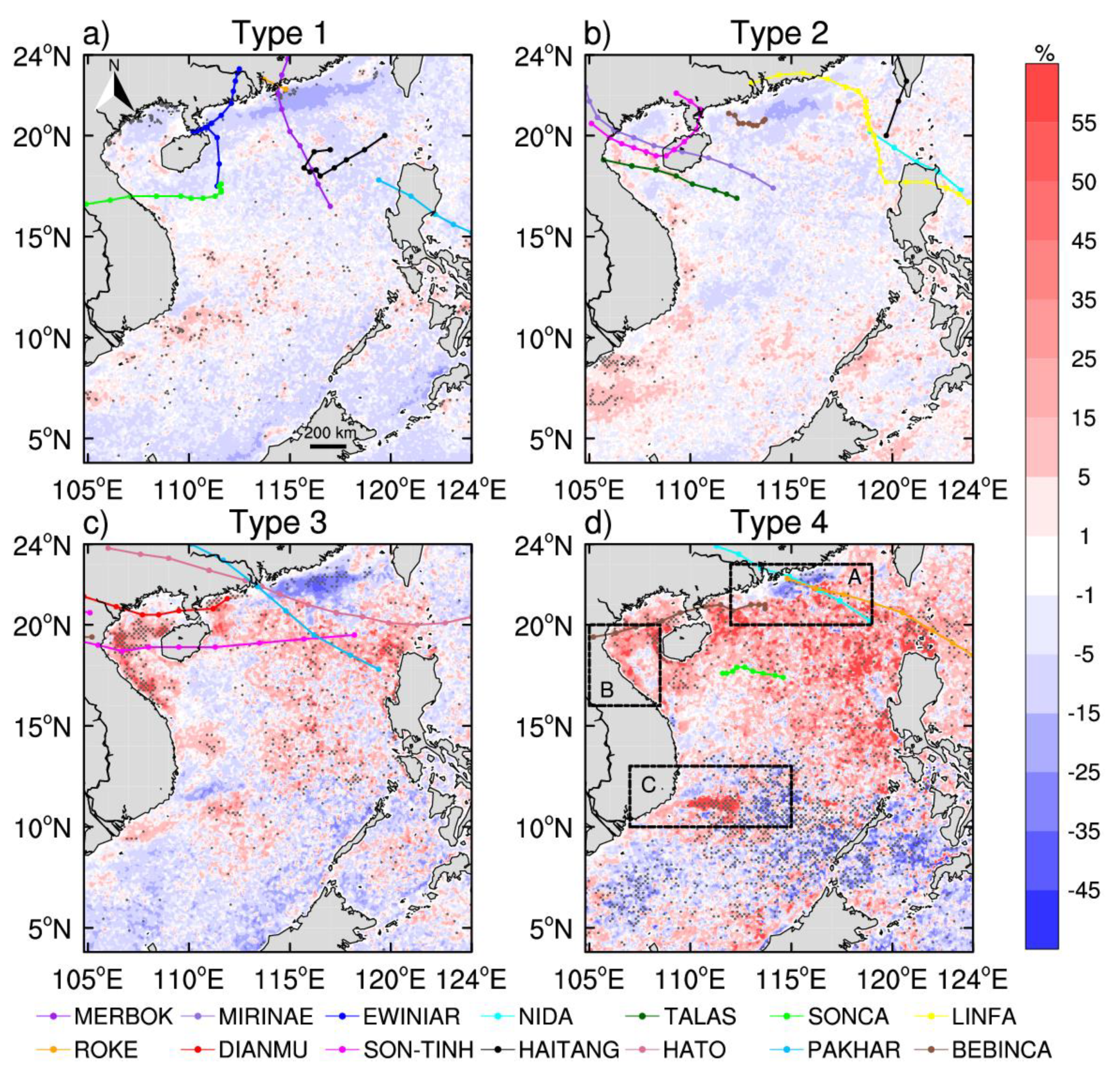
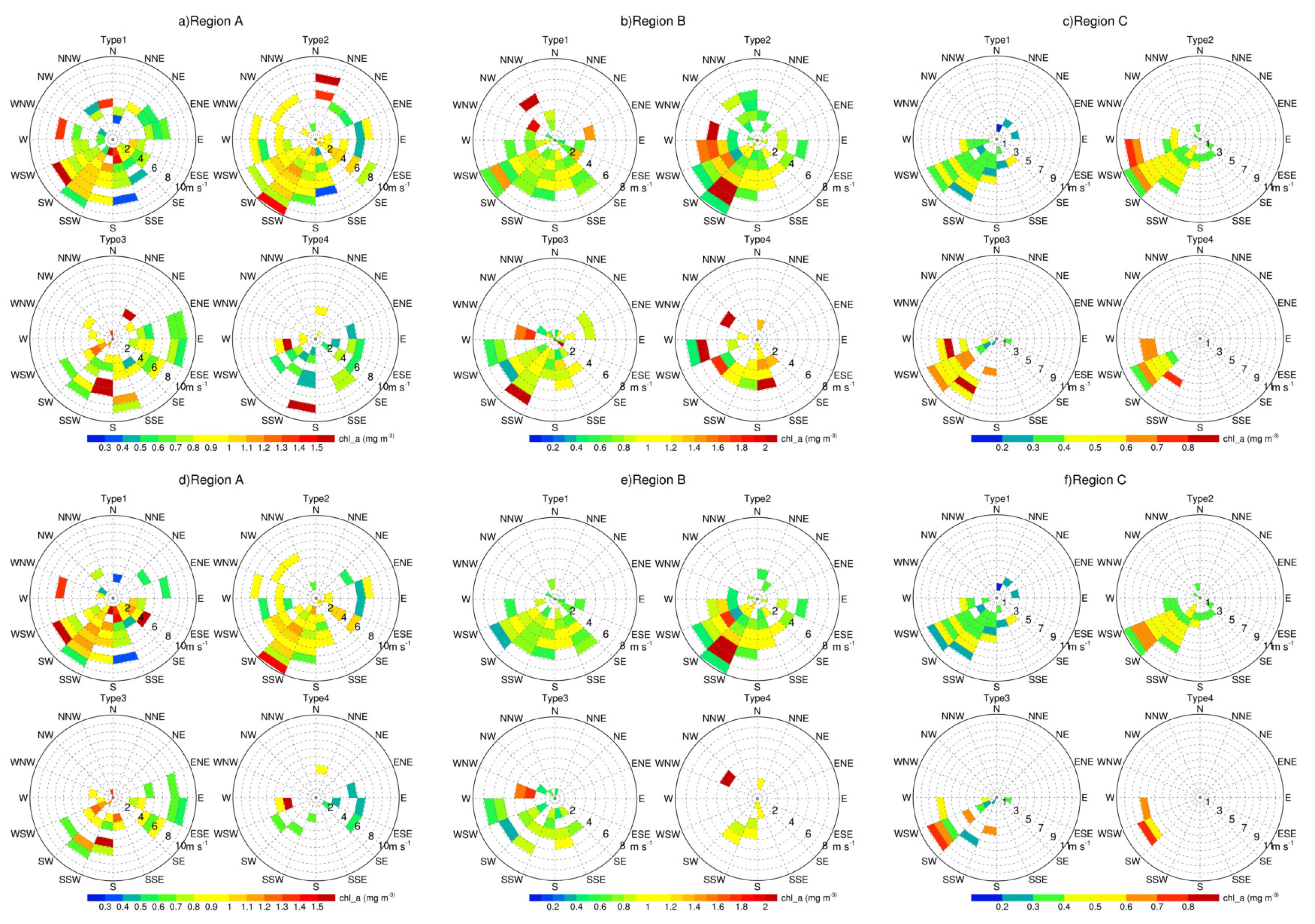
| Type1 | Type2 | Type3 | Type4 | |
|---|---|---|---|---|
| Region A | 0.51 | 0.50 | 0.55 | 0.43 |
| Region B | 0.30 | 0.18 | 0.41 | 0.39 |
| Region C | 0.40 | 0.36 | 0.38 | 0.42 |
| Mean Ekman Pumping Velocity/Mean Ekman Transport Component Vertical to the Coastline | ||||
|---|---|---|---|---|
| Type 1 | Type 2 | Type 3 | Type 4 | |
| Region A | −1.06/−0.20 | 0.44/−0.23 | 5.28/0.30 | −0.46/0.02 |
| Region C | −2.97/1.74 | −0.57/1.72 | 6.82/2.50 | 15.33/1.95 |
| Type 1 | Type 2 | Type 3 | Type 4 | |
|---|---|---|---|---|
| Typhoon number | 6 | 7 | 5 | 4 |
| Typhoon affected days * | 40 | 27 | 23 | 20 |
| Percentage of days affected by typhoons (%) | 29.4 | 23.1 | 44.2 | 62.5 |
Publisher’s Note: MDPI stays neutral with regard to jurisdictional claims in published maps and institutional affiliations. |
© 2021 by the authors. Licensee MDPI, Basel, Switzerland. This article is an open access article distributed under the terms and conditions of the Creative Commons Attribution (CC BY) license (https://creativecommons.org/licenses/by/4.0/).
Share and Cite
Liu, S.; Yang, Y.; Tang, D.; Yan, H.; Ning, G. Association between the Biophysical Environment in Coastal South China Sea and Large-Scale Synoptic Circulation Patterns: The Role of the Northwest Pacific Subtropical High and Typhoons. Remote Sens. 2021, 13, 3250. https://doi.org/10.3390/rs13163250
Liu S, Yang Y, Tang D, Yan H, Ning G. Association between the Biophysical Environment in Coastal South China Sea and Large-Scale Synoptic Circulation Patterns: The Role of the Northwest Pacific Subtropical High and Typhoons. Remote Sensing. 2021; 13(16):3250. https://doi.org/10.3390/rs13163250
Chicago/Turabian StyleLiu, Shuhong, Yuanjian Yang, Danling Tang, Hong Yan, and Guicai Ning. 2021. "Association between the Biophysical Environment in Coastal South China Sea and Large-Scale Synoptic Circulation Patterns: The Role of the Northwest Pacific Subtropical High and Typhoons" Remote Sensing 13, no. 16: 3250. https://doi.org/10.3390/rs13163250







